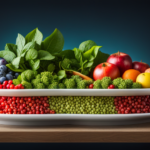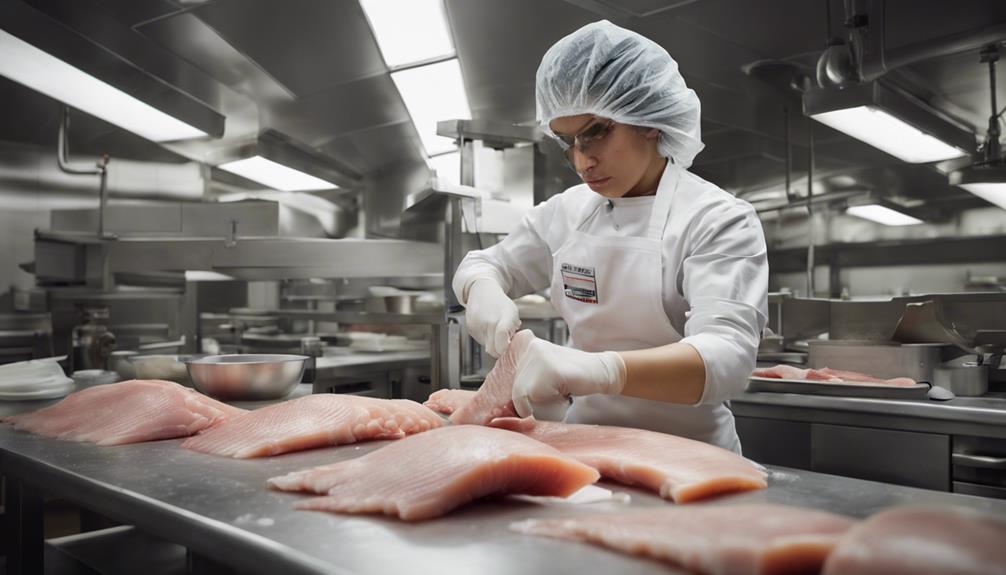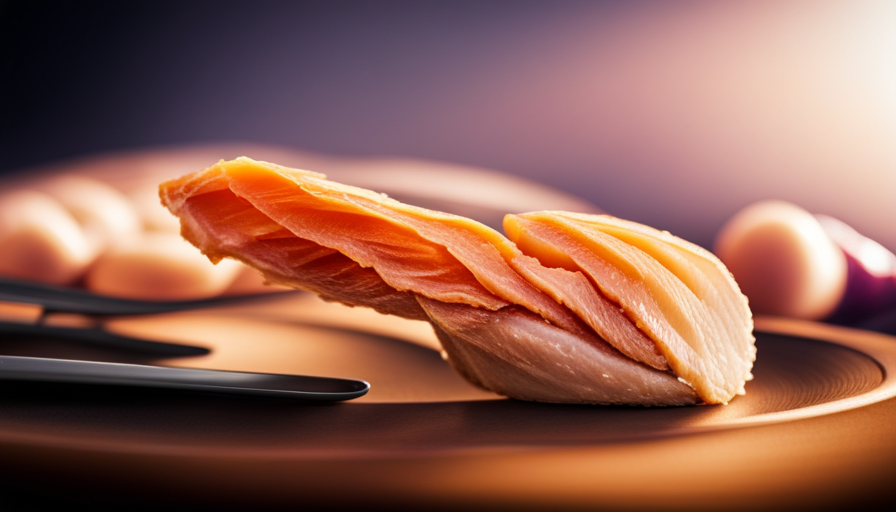As I start my quest for a healthier lifestyle, I am reminded of the abundance of nutrients provided by nature. The raw food diet, like a colorful tapestry crafted by Mother Earth, provides a diverse range of foods that not only fuel our bodies but also stimulate our senses.
These foods, brimming with vitality and life force, hold the key to unlocking our true potential.
Picture a luscious garden filled with an abundance of fresh fruits, their colors reminiscent of a beautiful sunrise. Or imagine a lush forest, where vibrant greens beckon you to indulge in their nutrient-packed goodness.
From crunchy vegetables that burst with flavor, to sprouts that add a delightful crunch to every bite, the raw food diet offers a cornucopia of options to tantalize your taste buds.
But it doesn’t stop there. Nuts and seeds provide a satisfying crunch and a wealth of healthy fats, protein, and fiber. Superfoods, like chia seeds and spirulina, elevate your nutrient intake to new heights. And for those moments when your sweet tooth calls, raw chocolate made from cacao beans offers a guilt-free indulgence.
So join me as we explore the world of raw food, unlocking the secrets to vibrant health and well-being. Together, let’s savor the deliciousness and power of these must-eat foods on our raw food journey.
Key Takeaways
- Fresh fruits such as oranges and berries are essential for a raw food diet as they provide natural sweetness and are rich in essential nutrients.
- Leafy greens like spinach, kale, and lettuce are nutrient-dense and support overall health, strengthen the immune system, improve digestion, and promote healthy skin.
- Raw vegetables like carrots, cucumbers, and bell peppers are low in calories and packed with vitamins and minerals, improving digestion, promoting weight loss, and enhancing overall well-being.
- Sprouts like alfalfa, broccoli, and mung bean add enzymes and antioxidants to salads and wraps, are rich in essential nutrients, and aid in digestion and nutrient absorption.
Fresh Fruits: Enjoy a variety of juicy and vibrant fruits like oranges, berries, and watermelon for a burst of natural sweetness and essential nutrients.
Indulge in a plethora of succulent fruits like oranges, berries, and watermelon to savor their natural sweetness and nourishing goodness. When following a raw food diet, incorporating fresh fruits is essential for reaping the benefits of this lifestyle. Not only do fruits provide a burst of natural sweetness, but they’re also packed with essential nutrients that promote overall health.
One of the key benefits of a raw food diet is the abundance of vitamins, minerals, and antioxidants found in fresh fruits. Oranges, for example, are rich in vitamin C, which boosts the immune system and supports collagen production for healthy skin. Berries, such as blueberries and strawberries, are loaded with antioxidants that protect against cell damage and lower the risk of chronic diseases.
In addition to their nutritional value, fruits are also versatile and easy to incorporate into your daily meals. You can enjoy them as a refreshing snack, blend them into smoothies, or add them to salads for a burst of flavor. To incorporate more raw foods into your diet, try starting your day with a fruit salad or swapping your usual dessert for a bowl of mixed berries.
As you focus on incorporating more fruits into your raw food diet, remember to experiment with different varieties to keep your meals exciting and varied. By doing so, you won’t only satisfy your sweet tooth but also nourish your body with the essential nutrients it needs.
Now, let’s transition to the next section and explore the benefits of leafy greens in a raw food diet.
Leafy Greens: Load up on nutrient-dense leafy greens such as spinach, kale, and lettuce to boost your energy and support overall health.
Try incorporating nutrient-dense leafy greens like spinach, kale, and lettuce into your meals for a natural energy boost and overall health support. Leafy greens are a crucial component of a raw food diet due to their numerous benefits. They are packed with essential vitamins, minerals, and antioxidants that promote optimal health. Including these greens in your diet can help strengthen your immune system, improve digestion, and promote healthy skin.
One way to enjoy leafy greens is by incorporating them into energy boosting smoothies. Simply blend a handful of spinach or kale with your favorite fruits and a liquid base like almond milk or coconut water. This combination not only provides an instant energy boost, but it also ensures that you are getting a good dose of vitamins and minerals.
To showcase the benefits of leafy greens, here is a table highlighting some of the key nutrients found in popular greens:
| Leafy Green | Nutrients | Benefits |
|---|---|---|
| Spinach | Iron, Vitamin K, Vitamin C | Supports healthy bones and blood |
| Kale | Fiber, Vitamin A, Vitamin C | Promotes heart health and vision |
| Lettuce | Folate, Vitamin K, Vitamin A | Enhances brain function and eye health |
Incorporating leafy greens into your raw food diet is a simple way to enhance your overall health and well-being. They provide a delicious and nutritious foundation for your meals and can be easily enjoyed in salads, wraps, or as a side dish. So, go ahead and indulge in these vibrant greens for a vibrant and energized you.
Crunchy vegetables like carrots, cucumbers, and bell peppers make delicious and satisfying snacks that are packed with vitamins and minerals.
Raw Vegetables: Crunchy vegetables like carrots, cucumbers, and bell peppers make delicious and satisfying snacks that are packed with vitamins and minerals.
Satisfy your cravings and boost your nutrient intake with crunchy vegetables like carrots, cucumbers, and bell peppers as delicious and nutritious snacks. Raw vegetables are a staple of a raw food diet and provide a wide range of health benefits.
Not only are they low in calories, but they’re also packed with essential vitamins, minerals, and fiber. Incorporating raw vegetables into your diet can help improve digestion, promote weight loss, and enhance overall well-being.
There are numerous raw vegetable recipes that you can try to add variety and flavor to your meals. For example, you can make a refreshing cucumber salad by combining sliced cucumbers, cherry tomatoes, red onions, and a drizzle of lemon juice and olive oil. Or, you can create a colorful and crunchy bell pepper slaw by mixing thinly sliced bell peppers, shredded carrots, and a tangy vinaigrette dressing.
The benefits of a raw food diet are plentiful, and raw vegetables play a crucial role in supporting these benefits. They’re rich in antioxidants, which help protect against oxidative stress and reduce the risk of chronic diseases. Additionally, raw vegetables provide enzymes that aid in digestion and help the body absorb nutrients more efficiently.
Transitioning to the next section, sprouts like alfalfa, broccoli, and mung bean add a nutritious and crunchy element to salads and wraps, providing enzymes and antioxidants.
Sprouts: Sprouts like alfalfa, broccoli, and mung bean add a nutritious and crunchy element to salads and wraps, providing enzymes and antioxidants.
Sprouts like alfalfa, broccoli, and mung bean bring a nutritious and crunchy twist to your salads and wraps, adding enzymes and antioxidants for a burst of flavor and health benefits. Incorporating sprouts into your raw food diet not only enhances the taste and texture of your meals but also provides numerous benefits.
Sprouts are rich in essential nutrients such as vitamins, minerals, and fiber. They’re also a great source of enzymes, which aid in digestion and nutrient absorption.
One of the creative ways to incorporate sprouts into your meals is by adding them to salads. Simply toss a handful of sprouts with your favorite greens, vegetables, and dressing for an extra crunch and a boost of nutrients. You can also use sprouts as a filling for wraps or sandwiches. They add a refreshing and crisp element to the dish, making it more satisfying and nutritious.
The benefits of sprouts extend beyond their taste and texture. They’re packed with antioxidants that help fight off free radicals and reduce inflammation in the body. Additionally, sprouts are low in calories and high in fiber, making them a great option for weight management and promoting a healthy digestive system.
As we move on to the next section about nuts and seeds, incorporating a variety of raw nuts and seeds like almonds, chia seeds, and walnuts will provide you with a source of healthy fats, protein, and fiber.
Nuts and Seeds: Incorporate a variety of raw nuts and seeds like almonds, chia seeds, and walnuts for a source of healthy fats, protein, and fiber.
Incorporating a variety of raw nuts and seeds like almonds, chia seeds, and walnuts may just be the secret to adding a deliciously ironic twist of healthy fats, protein, and fiber to your meals. When it comes to a raw food diet, these little powerhouses are packed with numerous benefits.
Firstly, nuts and seeds are rich in healthy fats, which are essential for brain function, hormone production, and overall cell health. They also provide a good amount of protein, which is important for muscle repair and growth. Lastly, they are a great source of fiber, aiding in digestion and promoting a healthy gut.
Now, let’s talk about some creative ways to incorporate nuts and seeds into your daily meals on a raw food diet. You can sprinkle a handful of almonds or chia seeds over your morning smoothie or yogurt bowl for an extra crunch. Adding crushed walnuts to your salad not only adds a delicious nutty flavor but also adds a satisfying texture. You can also make a raw nut and seed butter by blending them together, creating a versatile spread that can be used in sandwiches or as a dip for fruits and vegetables.
By incorporating nuts and seeds into your raw food diet, you can enjoy the benefits of healthy fats, protein, and fiber while adding a variety of flavors and textures to your meals. So why not give it a try and see how these little powerhouses can enhance your raw food journey?
Now, let’s move on to the next section about raw dairy alternatives: try plant-based dairy alternatives like almond milk, cashew cheese, and coconut yogurt for a creamy and nutritious option.
Raw Dairy Alternatives: Try plant-based dairy alternatives like almond milk, cashew cheese, and coconut yogurt for a creamy and nutritious option.
Try incorporating plant-based dairy alternatives like almond milk, cashew cheese, and coconut yogurt into your daily meals for a luxurious and nourishing option.
These dairy-free alternatives provide a creamy and delicious taste while also being packed with nutrients. Whether you’re lactose intolerant, following a vegan lifestyle, or simply looking for a healthier option, these creamy plant-based options are worth a try.
Almond milk is a popular choice among dairy alternatives. It’s made by blending almonds with water and then straining the mixture to remove any solids. Almond milk is low in calories and doesn’t contain cholesterol or saturated fat. It’s also a good source of vitamin E, an antioxidant that helps protect your cells from damage.
Cashew cheese is another creamy alternative that can be used in a variety of dishes. It’s made from soaked cashews blended with water and flavored with nutritional yeast and other seasonings. Cashew cheese provides a cheesy texture and taste without the dairy. It’s also a good source of healthy fats and protein.
Coconut yogurt is a refreshing and tangy option that’s perfect for breakfast or as a snack. It’s made from coconut milk and probiotics, which promote a healthy gut. Coconut yogurt is rich in medium-chain triglycerides (MCTs), a type of fat that can be easily digested and used for energy.
Incorporating these dairy-free alternatives into your diet can provide you with a creamy and nutritious option that’s also free from animal products. By exploring the world of superfoods such as chia seeds, spirulina, and maca powder, you can further enhance your nutrient intake and overall well-being.
Superfoods: Explore the world of superfoods such as chia seeds, spirulina, and maca powder to boost your nutrient intake and enhance your overall well-being.
Take a journey into the world of superfoods and discover how chia seeds, spirulina, and maca powder can supercharge your nutrient intake and boost your overall well-being. Incorporating superfoods into your diet can have numerous benefits, especially when consumed in smoothies. Here are four reasons why you should consider adding these powerful ingredients to your daily routine:
-
Chia seeds: These tiny seeds are packed with omega-3 fatty acids, fiber, and antioxidants. Adding them to your smoothies can help improve digestion, promote heart health, and boost energy levels.
-
Spirulina: This blue-green algae is a complete protein source and contains essential vitamins, minerals, and antioxidants. It can enhance your immune system, support detoxification, and improve endurance and muscle strength.
-
Maca powder: Derived from a root vegetable, maca powder is rich in vitamins, minerals, and adaptogenic compounds. It can help balance hormones, increase energy and stamina, and improve mood and cognitive function.
-
Supercharged nutrient intake: Incorporating superfoods into your diet can provide an array of essential nutrients that may be lacking in a raw food diet. These nutrient-dense ingredients can help support overall health and well-being.
So, why not give these superfoods a try and experience their powerful benefits in your own life? In the next section, we will explore the delicious world of raw chocolate, a healthier alternative that satisfies your sweet tooth while providing antioxidants and other health benefits.
Raw Chocolate: Indulge in raw chocolate made from cacao beans, which is rich in antioxidants and can satisfy your sweet tooth in a healthier way.
Get ready to indulge in the decadent world of raw chocolate, a guilt-free treat that not only satisfies your sweet tooth but also provides a plethora of antioxidants for a healthier indulgence.
Raw chocolate, made from cacao beans, is rich in flavonoids and polyphenols that have been shown to have numerous health benefits. These antioxidants help fight against free radicals in the body, reducing the risk of chronic diseases such as heart disease and certain types of cancer.
One of the great things about raw chocolate is that you can easily make it at home using simple ingredients. There are many raw chocolate recipes available that allow you to customize the flavor and sweetness to your liking. You can add nuts, dried fruits, or even superfoods like chia seeds and maca powder to enhance the nutritional profile of your homemade raw chocolate.
Not only is raw chocolate delicious and nutritious, but it can also boost your mood and improve cognitive function. It contains compounds like theobromine and phenylethylamine, which can increase feelings of happiness and promote mental clarity.
Now that you know the benefits of raw chocolate, it’s time to explore the next section about fermented foods. Incorporating fermented foods like sauerkraut, kimchi, and kombucha into your diet can support gut health and digestion.
Fermented Foods: Incorporate fermented foods like sauerkraut, kimchi, and kombucha to support gut health and digestion.
Incorporate fermented foods like sauerkraut, kimchi, and kombucha into your meals to support gut health and improve digestion. By regularly consuming these probiotic-rich foods, you may experience reduced bloating and improved nutrient absorption, leading to a healthier digestive system.
For example, a study showed that individuals who added kimchi to their daily meals reported a decrease in gastrointestinal discomfort and an increase in overall gut health.
Here are some discussion ideas about the health benefits of fermented foods and how to incorporate them into your daily diet:
- Boosts Digestive Health: Fermented foods contain beneficial bacteria that can help balance the gut microbiota, aiding in digestion and promoting a healthy gut.
- Enhances Nutrient Absorption: The fermentation process breaks down nutrients into more easily absorbable forms, allowing your body to extract maximum nutrition from the foods you eat.
- Supports Immune Function: The probiotics found in fermented foods can strengthen your immune system, helping to fight off harmful pathogens.
- Improves Mood and Mental Health: Emerging research suggests that a healthy gut can positively impact mental well-being, and fermented foods may contribute to a balanced gut microbiome.
To incorporate fermented foods into your daily diet, try adding sauerkraut or kimchi as a side dish, or enjoy a glass of kombucha with your meals. Experiment with different flavors and brands to find the ones you enjoy the most.
Now, let’s move on to the next section about raw desserts: treat yourself to delicious and guilt-free raw desserts like raw cheesecake, energy balls, and fruit sorbets for a satisfying end to your meals.
Raw Desserts: Treat yourself to delicious and guilt-free raw desserts like raw cheesecake, energy balls, and fruit sorbets for a satisfying end to your meals
Indulge in mouthwatering and guilt-free raw desserts like creamy raw cheesecake, energy-packed energy balls, and refreshing fruit sorbets, treating yourself to a truly satisfying end to your meals. Raw desserts are a fantastic way to satisfy your sweet tooth while still sticking to a raw food diet. Not only are they delicious, but they also offer a range of health benefits.
Raw dessert recipes often use natural and unprocessed ingredients, such as nuts, dates, and fruits. These ingredients are full of vitamins, minerals, and antioxidants that are beneficial for your overall health. They can help boost your immune system, support digestion, and provide a good source of energy.
Incorporating raw desserts into your diet can also help with weight management. Since these desserts are typically made with whole foods and are free from refined sugars and unhealthy fats, they can be a healthier alternative to traditional desserts. They can satisfy your cravings without causing a spike in blood sugar levels or adding unnecessary calories.
To give you an idea of the variety of raw desserts you can enjoy, here is a table showcasing three popular raw dessert recipes:
| Dessert | Ingredients | Benefits |
|---|---|---|
| Creamy Raw Cheesecake | Cashews, dates, coconut oil, lemon juice | High in healthy fats and antioxidants |
| Energy Balls | Almonds, dates, cocoa powder | Packed with protein and natural sweetness |
| Fruit Sorbets | Frozen fruits, coconut water | Refreshing and hydrating, rich in vitamins |
Incorporating raw desserts into your raw food diet can provide you with a satisfying and guilt-free end to your meals. These desserts offer a range of health benefits and can be a delicious way to indulge your sweet cravings while still nourishing your body.
Frequently Asked Questions
Are there any specific fruits that are recommended for a raw food diet?
When it comes to a raw food diet, certain fruits are highly recommended. Take apples, for example. They have specific benefits like being rich in fiber and antioxidants, which can promote good digestion and boost your immune system.
However, it’s important to be aware of potential drawbacks, such as high sugar content in some fruits, which may affect blood sugar levels. So, it’s wise to consume a variety of fruits to ensure a well-rounded nutritional profile.
Can I eat cooked vegetables while on a raw food diet?
No, on a raw food diet, you shouldn’t eat cooked vegetables as they’re heated above 118°F, which can destroy enzymes and other nutrients. The purpose of a raw food diet is to consume foods in their natural state to maximize their nutritional value.
Similarly, raw dairy products aren’t recommended on a raw food diet as they’re processed and pasteurized, which can diminish their nutritional content.
What are some examples of fermented foods that can be included in a raw food diet?
Fermented foods are a great addition to a raw food diet. They provide numerous benefits, such as improving digestion and boosting the immune system.
Examples of fermented foods that can be included are sauerkraut, kimchi, and fermented pickles. These foods are rich in probiotics, which promote the growth of beneficial bacteria in the gut.
Incorporating fermented foods into a raw food diet can enhance nutrient absorption and support overall gut health.
Are there any restrictions on the types of nuts and seeds that can be consumed on a raw food diet?
There aren’t generally any restrictions on the types of nuts and seeds allowed on a raw food diet. In fact, incorporating a variety of nuts and seeds can provide numerous health benefits. Nuts and seeds are rich in essential fats, proteins, vitamins, and minerals. They can help improve heart health, support brain function, and boost overall energy levels. However, it’s important to consume them in moderation as they’re also high in calories.
Can I still enjoy desserts while following a raw food diet?
Yes, you can still enjoy desserts while following a raw food diet. There are plenty of raw dessert recipes that are delicious and healthy. Instead of traditional desserts, which are often loaded with refined sugars and unhealthy fats, you can opt for alternatives like raw fruit tarts, chocolate avocado mousse, or raw coconut macaroons. These desserts not only satisfy your sweet tooth, but they also provide nutrients and are made with wholesome, unprocessed ingredients.
Can I follow a raw food diet while playing Frostpunk and still meet my nutritional needs?
While playing Frostpunk, it can be a challenge acquiring raw food in Frostpunk, but it’s possible to follow a raw food diet and meet nutritional needs. Focus on gathering from foraged sources and utilizing the resources available within the game to ensure you can maintain a healthy, raw food diet while playing.
Conclusion
In conclusion, embarking on a raw food diet can be a transformative journey for your health and well-being. By nourishing your body with an abundance of fresh fruits, leafy greens, raw vegetables, sprouts, nuts and seeds, superfoods, raw chocolate, fermented foods, and raw desserts, you’re symbolically embracing the power of nature’s gifts.
With each bite, you’re fueling your body with vibrant nutrients and supporting its natural processes. So, why not take a step towards a healthier and more vibrant life by incorporating these delicious and nutritious foods into your raw food diet? Your body’ll thank you.

















